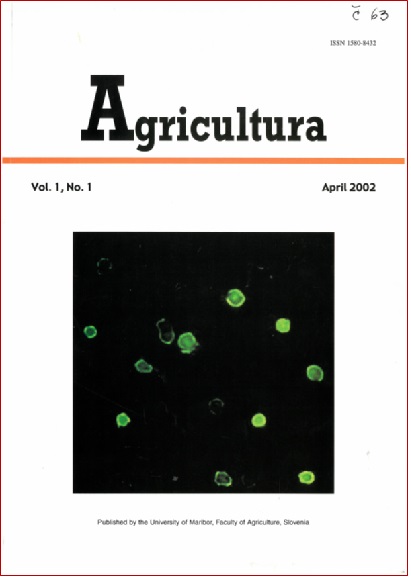Bovine spongiform encephalopathy: epidemiology and diagnosis
DOI:
https://doi.org/10.18690/agricultura.1.1.1-7.2002Keywords:
bovine spongiform encephalopathy, epidemiology, diagnosis, testAbstract
Bovine spongiform encephalopathy (BSE) belongs to the group of of so-called “prion diseases”. These fatal neurodegenerative diseases are characterised by long incubation periods, and in the clinical phase by the presence of amyloid deposits, in the central nervous system, of an abnormally folded form of a host protein, PrP. BSE emerged in the UK in 1986, probably through feeding cattle with animal proteins from infected carcasses, possibly those of scrapie-infected sheep. Not only BSE was exported to other countries in Europe via MBM and live cattle, but it was most probably the origin in humans of a variant of Creutzfzeld-Jacob disease (vCJD), first described in Great Britain in 1996. vCJD incidence is regularly increasing, most cases being among UK citizens. Due to a very difficult clinical diagnosis, BSE incidence in countries outside UK has been and still is most probably underestimated. Some countries (Germany, Spain, Italy) have ignored indigenous BSE cases until 2001, when EU directives implemented systematic tests for over 30 months cattlle entering the food chain. Present tests approved by the EU rely upon detection of abnormal PrP (proteinase K resistant) in the brain of cattle after slaughter. These tests provide a reasonable precautionary measure for protection of human health (the best precaution being the removal of SRM from carcasses), but cannot help much the eradication of BSE. Control and eradication of BSE will depend on specific and sensitive diagnostic tests that could be applied on live animals early in infection. Several recently published results give some hope that such early diagnostic tests might be available in a near future.
Downloads
References
Braun U, Schicker E, Hornlimann B. Diagnostic reliability of clinical signs in cows with suspected bovine spongiform encephalopathy. Vet Rec. 1998;143:101-5.
Bruce ME, Will RG, Ironside JW, McConnell I, Drummond D, Suttie A, BOVINE SPONGIFORM ENCEPHALOPATHY 6 McCardle L, Chree A, Hope J, Birkett C, Cousens S, Fraser H,Bostock CJ. Transmissions to mice indicate that 'new variant' CJD is caused by the BSE agent. Nature 1997;389:498-501.
Carp RI, Meeker HC, Rubenstein R, Sigurdarson S, Papini M, Kascsak RJ, Kozlowski PB, Wisniewski HM. Characteristics of scrapie isolates derived from hay mites. J. Neurovirol. 2000;6:137-44.
Collinge J, Sidle KC, Meads J, Ironside J, Hill AF. Molecular analysis of prion strain variation and the aetiology of 'new variant' CJD. Nature 1996;383:685-90.
Collinge, J. Variant Creutzfeld-Javob disease. Lancet 1999;354:317 - 23.
Fischer M B, Roeckl C, Parizek P, Schwarz H.P, Aguzzi A. Binding of diseaseassociated prion protein to plasminogen. Nature 2000;408:479-83.
Hill A.F, Desbruslais M, Joiner S, Sidle KC, Gowland I, Collinge J, Doey LJ, Lantos P. The same prion strain causes vCJD and BSE. Nature 1997;44850
Huang Z, Prusiner SB, Cohen FE. Structures of prion proteins and conformational models for prion diseases. In : Prusiner S.B. (ed), Prions, Prions, Prions. Springer-Verlag, Berlin Heidelberg New York, 1996:4965.
Lasmezas CI, Deslys JP, Demaimay R, Adjou KT, Lamoury F, Dormont D, Robain O, Ironside J, Hauw JJ. BSE transmission to macaques. Nature 1996;381:743-4.
Liemann S, Glockshuber R. Transmissible spongiform encephalopathies. "Breakthrough and Views". Biochem. Biophys. Res. Comm. 1998;250:187-93.
Maissen M, Roeckl C, Glatzel M, Goldmann W, Aguzzi A. Plasminogen binds to disease-associated prion protein of multiple species. Lancet 2001;357:2026-8.
Prusiner SB. Novel proteinaceous infectious particles cause scrapie. Science 1982; 216:136-44.
Prusiner SB. Prions. Proc. Nat. Sci. USA 1998; 95:13363-83.
Saborio GP, Permanne B, Soto C. Sensitive detection of pathological prion protein by cyclic amplification of protein misfolding. Nature 2001;411:810-13.
Schmerr MJ, Jenny AL, Bulgin MS, Miller JM, Hamir AN, Cutlip RC, Goodwin KR. Use of capillary electrophoresis and fluorescent labeled peptides to detect the abnormal prion protein in the blood of animals
that are infected with a transmissible spongiform encephalopathy. J. Chromatogr. A. 1999;853:207-14.
Scientific Steering Committee. Final Opinion on the Geographical Risk of Bovine Spongiform Encephalopathy (GBR). date: 6/july/2000 website:http://europa.eu.int/comm/food/fs/sc/ssc/outcome_en.html#
opinions)
Scott MR, Will R, Ironside J, Nguyen HO, Tremblay P, DeArmond SJ, Prusiner SB. Compelling transgenetic evidence for transmission of bovine spongiform encephalopathy prions to humans. Proc. Natl. Acad. Sci. U S A. 1999 Dec 21;96(26):15137-42.
Shaked GM, Shaked Y, Kariva Z, Halimi M, Avraham I, Gabizon R. A protease resistant isoform is present in urine of animals and humans affected with prion diseases. J. Biol. Chem. 2001 (in press).
Wells GA, Hawkins SA, Green RB, Austin AR, Dexter I, Spencer YI, Chaplin MJ, Stack MJ, Dawson M. Preliminary observations on the pathogenesis of experimental bovine spongiform encephalopathy (BSE): an update. Vet Rec. 1998;142:103-6.
Wilesmith JW, Ryan JB, Atkinson MJ. Bovine spongiform encephalopathy: epidemiological studies on the origin. Vet. Rec. 1991;128:199-203.
Wilesmith JW, Ryan JB. Absence of BSE in the offspring of pedigree suckler cows affected by BSE in Great Britain. Vet. Rec. 1997;141:250-1.
Wilesmith JW, Wells A, Ryan JB, Gavier-Widen D, Simmons MM. A cohort study to examine maternally-associated risk factors for bovine spongiform encephalopathy. Vet. Rec.1997;141:239-43.
Will RG, Ironside JW, Zeidler M, Cousens SN, Estibeiro K, Alperovitch A, Poser S, Pocchiari M, Hofman A, Smith PG. A new variant of Creutzfeldt-Jakob disease in the UK. Lancet 1996;347:921-5.
Wisniewski HM, Sigurdarson S, Rubenstein R, Kascsak RJ, Carp RI. Mites as vectors for scrapie. Lancet 1996;347:1114.
